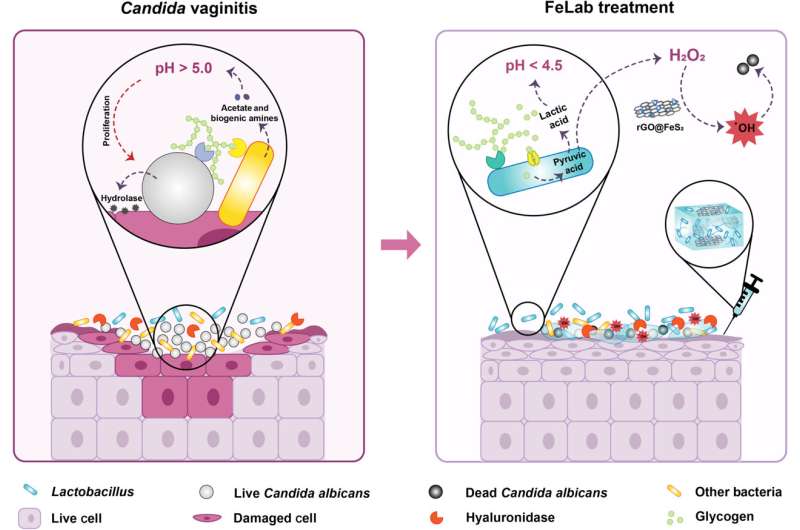This article has been reviewed according to Science X's editorial process and policies. Editors have highlighted the following attributes while ensuring the content's credibility:
fact-checked
peer-reviewed publication
trusted source
proofread
Nanozyme hydrogel: A breakthrough solution for Candida vaginitis treatment

A team of researchers from Nanjing University has developed a probiotic nanozyme hydrogel to regulate the vaginal microenvironment for Candida vaginitis therapy. Candida vaginitis, a common fungal infection that affects about 75% of women worldwide, is known for its high recurrence rates and negative impact on women's health.
The vaginal microbiota, particularly the presence of beneficial bacteria like Lactobacillus, plays a crucial role in maintaining vaginal health and preventing infections. Current antifungal drugs used for Candida vaginitis treatment have limitations and can cause damage to normal cells and tissues, leading to further complications.
To address these challenges, the researchers explored the use of Lactobacillus-based probiotic therapy combined with nanozymes. They developed a responsive hydrogel containing hyaluronic acid (HA), reduced graphene oxide (rGO) loaded with FeS2 nanozymes, and Lactobacillus.
Their results are published in the journal Science Advances.
When applied to the vagina, the hydrogel releases Lactobacillus and nanozymes in response to the presence of hyaluronidase secreted by Candida albicans. Lactobacillus helps normalize the vaginal microenvironment by producing lactic acid, while the nanozymes catalyze the conversion of mild hydrogen peroxide (H2O2) to highly toxic hydroxyl radicals (•OH), effectively killing C. albicans.
The researchers characterized the rGO@FeS2 nanozymes and confirmed their stability and activity. The nanozymes demonstrated peroxidase-like activity, generating •OH from low concentrations of H2O2. They also exhibited strong anti-C. albicans activity, effectively reducing fungal colonies in vitro. The rGO@FeS2 nanozymes were found to be superior to other iron-containing nanozymes in terms of •OH generation and anti-C. albicans activity.
Furthermore, the researchers investigated the synergistic effect of Lactobacillus and rGO@FeS2 nanozymes. They observed that Lactobacillus fermentation produced H2O2 and lowered the pH, fulfilling the requirements for effective nanozyme activity. The cofermentation of Lactobacillus with C. albicans generated H2O2 and lowered the pH, indicating the potential for probiotic therapy. The combination of Lactobacillus and nanozymes enhanced the anti-C. albicans activity, including against clinical isolates.
In conclusion, the developed probiotic nanozyme hydrogel shows promise for the treatment of Candida vaginitis. By modulating the vaginal microenvironment and catalyzing the killing of C. albicans, the hydrogel effectively inhibits the growth of the fungus and reduces the likelihood of recurrence. Compared to existing clinical drugs, this system is safer for the vagina and offers potential for improved clinical treatment of Candida vaginitis.
More information: Gen Wei et al, A probiotic nanozyme hydrogel regulates vaginal microenvironment for Candida vaginitis therapy, Science Advances (2023). DOI: 10.1126/sciadv.adg0949
Journal information: Science Advances
Provided by Nanjing University



















